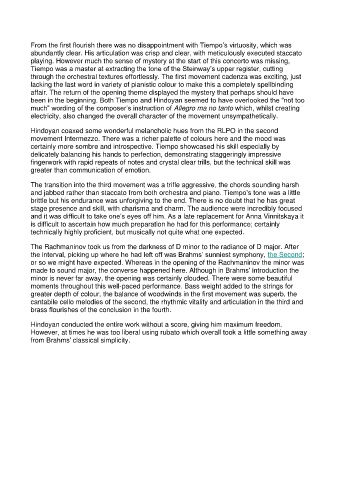Page 386 - Liverpool Philharmonic 22-23 Season Coverage Book
P. 386
From the first flourish there was no disappointment with Tiempo’s virtuosity, which was
abundantly clear. His articulation was crisp and clear, with meticulously executed staccato
playing. However much the sense of mystery at the start of this concerto was missing,
Tiempo was a master at extracting the tone of the Steinway’s upper register, cutting
through the orchestral textures effortlessly. The first movement cadenza was exciting, just
lacking the last word in variety of pianistic colour to make this a completely spellbinding
affair. The return of the opening theme displayed the mystery that perhaps should have
been in the beginning. Both Tiempo and Hindoyan seemed to have overlooked the “not too
much” wording of the composer’s instruction of Allegro ma no tanto which, whilst creating
electricity, also changed the overall character of the movement unsympathetically.
Hindoyan coaxed some wonderful melancholic hues from the RLPO in the second
movement Intermezzo. There was a richer palette of colours here and the mood was
certainly more sombre and introspective. Tiempo showcased his skill especially by
delicately balancing his hands to perfection, demonstrating staggeringly impressive
fingerwork with rapid repeats of notes and crystal clear trills, but the technical skill was
greater than communication of emotion.
The transition into the third movement was a trifle aggressive, the chords sounding harsh
and jabbed rather than staccato from both orchestra and piano. Tiempo’s tone was a little
brittle but his endurance was unforgiving to the end. There is no doubt that he has great
stage presence and skill, with charisma and charm. The audience were incredibly focused
and it was difficult to take one’s eyes off him. As a late replacement for Anna Vinnitskaya it
is difficult to ascertain how much preparation he had for this performance; certainly
technically highly proficient, but musically not quite what one expected.
The Rachmaninov took us from the darkness of D minor to the radiance of D major. After
the interval, picking up where he had left off was Brahms’ sunniest symphony, the Second;
or so we might have expected. Whereas in the opening of the Rachmaninov the minor was
made to sound major, the converse happened here. Although in Brahms' introduction the
minor is never far away, the opening was certainly clouded. There were some beautiful
moments throughout this well-paced performance. Bass weight added to the strings for
greater depth of colour, the balance of woodwinds in the first movement was superb, the
cantabile cello melodies of the second, the rhythmic vitality and articulation in the third and
brass flourishes of the conclusion in the fourth.
Hindoyan conducted the entire work without a score, giving him maximum freedom.
However, at times he was too liberal using rubato which overall took a little something away
from Brahms' classical simplicity.

